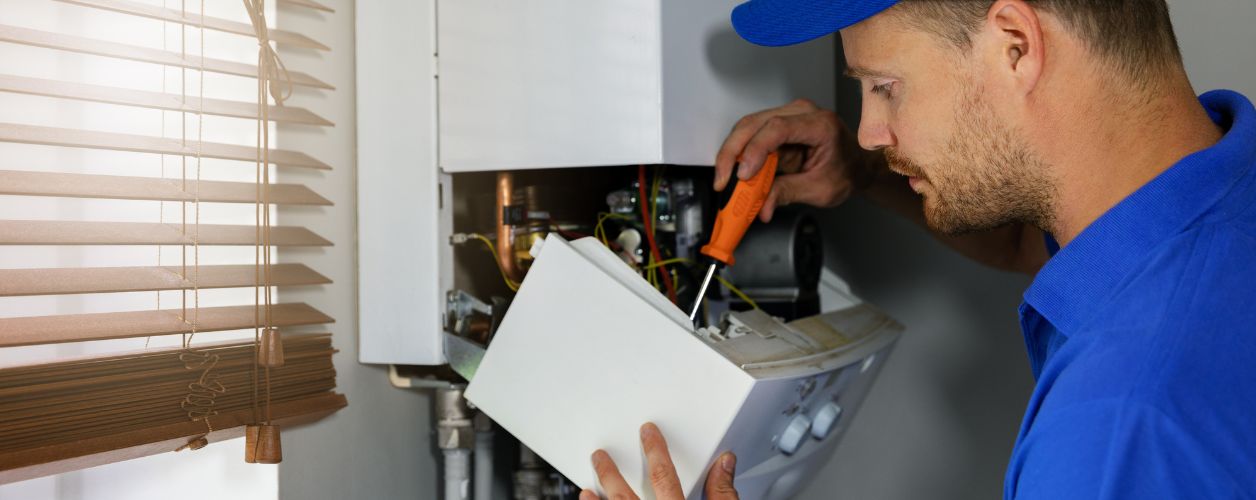Get free quotes within minutes
Gas vs Electric Heating: What’s More Efficient?

Table Of Contents
- Introduction
- Electric Heating Options
- Gas Heating Options
- Cost of Gas vs Electric Heating
- Utility Bill Comparison by Region
- Energy Efficiency Comparison
- More on Gas vs Electric Heating
- Hybrid Heating Systems: Can This Be An Option?
- Final Thoughts
Trying to decide between gas or electric heating for your home? Let’s break down the real-world costs, efficiency, and comfort to help you make the smartest choice.
Once winter arrives, homeowners begin weighing the options for heating. Comfort and energy costs are important factors, and both are dependent on whether one goes with electric or gas heating. Being aware of the differences enables you to choose the best for your climate and budget. You can even opt for a hybrid heating system that includes both.
This guide outlines how electric and gas heating systems function. It covers costs, safety, efficiency, installation, maintenance, and environmental impact. Let's go through all the facts so you can make the best choice for your home.
Electric Heating Options
Electric heat takes electric power and transforms it into heat. This heating system runs heaters, water heaters, stoves, and appliances. It works by transmitting electricity to a resistive heating unit. That device heats up and releases the warmth into your surroundings.
Electric heat can be clean and dependable in much of the country. Other states draw upon renewables such as hydro, wind, or nuclear power to power their homes. In those places, electric heating is a valid, green solution.
Electrification shifts the dependence on electricity instead of burning fossil fuels such as oil and gas. This causes fewer emissions and can be cheaper per energy cost, depending on your area. Electric heat only works if it helps you and the planet.
Electric heating is safe. Electric heating does not employ flammable gases or oils. There is no chance of gas leaks or fumes within your house. The initial investment required to install an electric heating system is normally lower than a gas system.
Yet, electricity tends to be more expensive than gas. Electric heat will cost more in the long run with your utility bills. It also heats a house more slowly. You are made to feel the warmth only after waiting for the element to become hot first. Therefore, during power outages, you lose every bit of heat until power is restored.
Types of Electric Heaters
- Forced Heat Furnace: One of the electric heaters is the forced heat furnace. It employs a blower to force air over hot coils. The hot air travels through ducts to heat your home. These systems need to be sized for your home. A system that is too large or too small will not function properly and may burn out quickly.
- Electric Baseboard Heaters: They warm rooms by convection. Cold air flows into the bottom, gets warmed by metal fins, and goes upwards. Heaters function most efficiently when installed under windows. They combat cold air entering through the glass. They require good clearance from the floor to perform optimally.
- Electric Wall Heaters: They are small and efficient. They consist of a heating element and a fan to heat a room. These need to be installed in every room. They are best suited for interior walls for better insulation.
Electric heaters differ in quality. Cheap heaters can be noisy and do not have temperature control. Check for safety certifications and compare product warranties.
Gas Heating Options
Gas heating ignites natural gas, propane, or oil to produce heat. The system employs a furnace or boiler. The system heats the air or water and then distributes it throughout your home. Combustion gases vent out of the house through a fuel pipe.
Gas heating is prevalent and available in much of the country. Gas lines underground bring fuel to your house, so you don't require deliveries. That makes gas heating convenient during blizzards.
One of the greatest benefits of gas heating is cost. Natural gas is less expensive than electricity in most places. Gas systems warm your house quicker as well. They produce air between 120 and 140 degrees Fahrenheit. That's a lot faster than electric heating systems.
Gas systems, though, have some disadvantages. They consume combustible fuel, which may produce pollutants. Leaks from the equipment or fuel may lead to health problems. Gas also makes the fire more likely. Gas heaters cost more to install than electric heaters. Gas systems also get worn out earlier.
Types of Gas Heaters
- Forced Air Gas Furnaces: Forced air gas furnaces are most prevalent. The cold air is pulled into the system using the heat exchanger. The gas burner heats the air and distributes it throughout the house via the ducts. Exhaust gases exit via vents or fuel.
- Hydronic or Radiant Heating Systems: A gas boiler heats the water, which travels through pipes and radiators. These systems require adequate ventilation to deal with combustion gases.
- Natural Gas Space Heaters: They warm one room at a time. They work on the principles of radiation or convection. Radiant heaters warm everything in their line of sight, while convective heaters warm the air. They are small and efficient. Some do not need to be vented.
- Space Heaters: They are not suited for heating an entire house. You need one per room. That makes them ideal for small houses or rooms that require additional heat.
Cost of Gas vs Electric Heating
The cost of installing electric heating is lower. A new electric furnace can cost between $1,568 and $6,574. Homeowners tend to average about $4,060 on an electric furnace. Location and size of residence can affect the costs.
Usually, it is more expensive to install a gas furnace. The cost has been put between $3,800 and $10,000. This encompasses equipment and labor. Gas heat, though, is less expensive to operate. Natural gas is less expensive than electricity in most regions.
Electric heaters tend to have a longer lifespan. They can last for 30 years. Gas heaters will typically last between 10 and 20 years. You can replace a gas system two times before having to replace an electric system.
Utility Bill Comparison by Region
- Electricity is more expensive in most areas. This breakdown by region shows:
- The Northeast has an average annual electric bill of $1,300. The gas bill is $1,030 on average.
- The South has electric bills averaging $1,430 and gas bills averaging $920.
- The Midwest has electricity at a cost of approximately $1,260 annually. Gas is only $665.
- The West has electric bills of approximately $1,235. Gas bills are about $670.
Gas heat triumphs in most regions on operating costs alone. But there are other considerations.
Energy Efficiency Comparison
Electric heaters turn all the energy they take in into heat. They use 100% of their energy at the user's end. Nonetheless, where they get the power from is the issue. Your power, for instance, generated from coal, will be less environmentally friendly. If generated by wind or sun, electric heating does not have an adverse environmental implication.
Gas heating is based on the system age and type. Older units might be less efficient. New gas furnaces provide greater efficiency but still dissipate heat via exhaust.
Energy costs are based on local utility rates. They vary with market conditions and policies. Always see rates locally when selecting a system.
More on Gas vs Electric Heating
Safety Considerations
Gas heaters require additional safety precautions. Leaks may result in fires or health issues. Fluid systems exhaust gases, but unfueled systems can keep fumes inside. You should fit carbon monoxide alarms and plan periodic inspections.
Electric heaters are generally safer. They do not burn fuel or emit gases. Most electric equipment features circuit breakers and thermal cut-offs. These protect against fires and overheating.
Installation Costs and Requirements
Electric systems are easier to install. You might require wiring upgrades, but no fuel or vents are necessary. Fuel connections are not needed for electric heaters either.
Gas systems take more effort. You have to install venting and gas lines. This comes at an extra cost. The two systems may require permits or inspections to conform to safety specifications.
Smart thermostats complement both types of heating units. They optimize comfort and conserve energy.
Environmental Impact
Gas heating releases carbon dioxide and other pollutants. This has implications for air quality and contributes to greenhouse gas emissions.
Electric heat can be clean if from renewables. If electricity is from coal or oil, then there is a greater environmental impact. 100% efficiency is experienced at the point of use, but generation losses lower the overall benefit.
Both systems have an environmental impact from production and disposal. Nevertheless, electric systems powered by renewable energy are kinder to the environment.
Maintenance Requirements
More maintenance is required for gas systems. You need to check the burner, fuel, and ventilation annually. Clean the heat exchanger and change filters regularly. Combustion issues can cause blockages or carbon accumulation.
Electric systems are simpler to maintain. Inspect the wiring, controls, and thermostats seasonally. Ensure that safety devices such as circuit breakers function. Though simpler, complicated electrical systems require professional checks.
Maintenance for gas systems is more expensive because of additional components and safety inspections. Electric system expenditures are less expensive but differ depending on the model.
Hybrid Heating Systems: Can This Be An Option?
Hybrid systems blend electric and gas heat. These operate an electric heat pump for moderate weather. When it gets cold, the system cuts over to gas heat. This arrangement provides you with the efficiency of electric heat plus the muscle of gas heat.
You have control over when to change manually, or the system will switch automatically. This type of system has the largest amount of energy savings.
A hybrid system costs more to install. The installation price ranges between $6,000 and $10,000. However, this system is capable of saving your energy expenditure up to 50% each year.
You might also be eligible for tax credits or rebates. Contact local and national programs to find out what opportunities are open to you. A hybrid vehicle still consumes fossil fuels in low temperatures. It also requires upkeep for both the gas and electric components.
Final Thoughts: Select What Suits Your Climate
Heating choice is based on climate, size of home, and budget. In colder regions, where winters can become harsh, a gas heater provides a steady delivery of warmth at lower costs. Electric heat could be less expensive and cleaner for climates with mild temperatures.
For those needing efficiency and adaptability, a hybrid system is best. Although more costly initially, it can pay off and minimize your carbon footprint in the long run.
No system you select matters if you take care of it. Plan regular inspections, clean filters, and review your thermostat settings. Clever heating decisions keep your house cozy and your energy bills in check.






